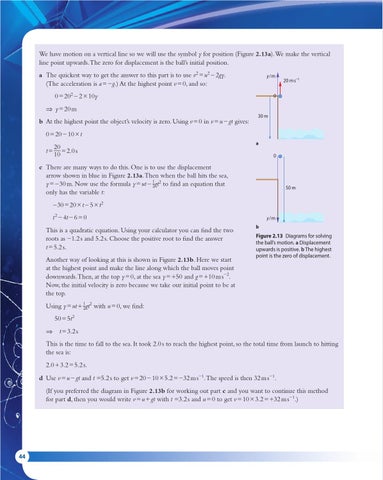We have motion on a vertical line so we will use the symbol y for position (Figure 2.13a). We make the vertical line point upwards. The zero for displacement is the ball’s initial position. a The quickest way to get the answer to this part is to use v2 = u2 − 2gy. (The acceleration is a = −g.) At the highest point v = 0, and so:
y /m
0 = 202 − 2 × 10y
20 m s–1
0
⇒ y = 20 m b At the highest point the object’s velocity is zero. Using v = 0 in v = u − gt gives:
30 m
0 = 20 − 10 × t t=
20 = 2.0 s 10
a 0
c There are many ways to do this. One is to use the displacement arrow shown in blue in Figure 2.13a. Then when the ball hits the sea, y = −30 m. Now use the formula y = ut − 12gt2 to find an equation that only has the variable t:
50 m
−30 = 20 × t − 5 × t2 t 2 − 4t − 6 = 0 This is a quadratic equation. Using your calculator you can find the two roots as −1.2 s and 5.2 s. Choose the positive root to find the answer t = 5.2 s. Another way of looking at this is shown in Figure 2.13b. Here we start at the highest point and make the line along which the ball moves point downwards. Then, at the top y = 0, at the sea y = +50 and g = +10 m s−2. Now, the initial velocity is zero because we take our initial point to be at the top.
y /m b
Figure 2.13 Diagrams for solving the ball’s motion. a Displacement upwards is positive. b The highest point is the zero of displacement.
Using y = ut + 12gt2 with u = 0, we find: 50 = 5t2 ⇒
t = 3.2 s
This is the time to fall to the sea. It took 2.0 s to reach the highest point, so the total time from launch to hitting the sea is: 2.0 + 3.2 = 5.2 s. d Use v = u − gt and t =5.2 s to get v = 20 − 10 × 5.2 = −32 m s−1. The speed is then 32 m s−1. (If you preferred the diagram in Figure 2.13b for working out part c and you want to continue this method for part d, then you would write v = u + gt with t =3.2 s and u = 0 to get v = 10 × 3.2 = +32 m s−1.)
44
